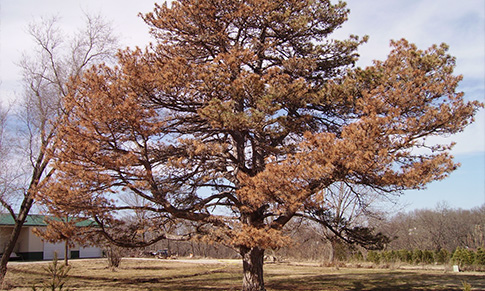Oak Wilt
Oak wilt is a disease caused by a fungus that is specific to oaks, with Red Oaks being the most susceptible. The fungus is spread through root grafts between neighboring trees and also by insects.

Within two months to one year the infection will causes leaf discoloration, defoliation and death. Red Oaks will form fungal mats under the bark and force outwards, cracking the bark of the tree. Fungal mats will not form in White Oaks and they are much more tolerant of the disease.
Symptoms
The initial symptoms of oak wilt be the browning of the leaves. Browning begins at the leaf tip and moves downward and inward toward the stem. Tree limbs will die off as the the disease progresses. Cracks will appear in the bark as fungal mats develop pushing the bark out. Untreated, within a short time (months), the tree will die.
Treatment Used
Propiconazole is the fungicide used to prevent and suppress the disease. Because oak wilt is spread through root grafts, it is recommended to treat non-infected oaks in close proximity to infected trees. Also, because insects also are carriers of the infection, if oak wilt has been discovered in an area non-infected oaks should be treated. Applying propiconazole before an infection will greatly reduce or eliminate likelihood of infection.
What To Expect After Treatment
The severity of the infection at the time of treatment will determine how successful the tree recovery will be. Propiconazole will kill and suppress the disease and allow the tree to refoiliate. The treatment lasts two years.
